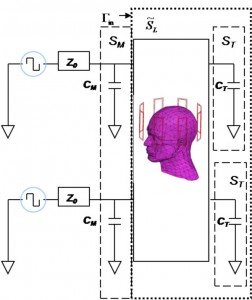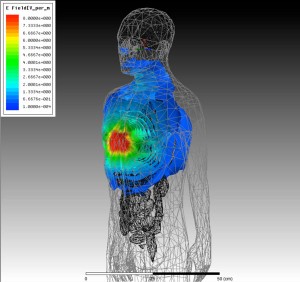Computational Electromagnetics Tools for High-field Magnetic Resonance Imaging
- Category: Medical Electronics
- Tags: Luca Daniel, Yan Zhao
Two recent advances in Magnetic Resonance Imaging (MRI) technology have resulted in a need for sophisticated computational electromagnetics (CEM) tools. The first is the availability of higher magnetic fields, which can be used to improve signal-to-noise ratio. The second is the availability of transmit-coil arrays, which can be used to minimize human-body heating by electric fields. The higher magnetic fields imply higher-frequency RF pulses, which complicate electromagnetic analysis, as the dimensions of the human body and wavelength become comparable. They also imply increased human-body heating, which limits the RF power used for imaging purposes. In the Computational Prototyping Group, we are leveraging known CEM techniques to address these new needs of the MRI community, working in close collaboration with the RLE MRI group. Also, we are using the MRI application to drive the development of new CEM methods.
A number of MRI-based applications are being targeted. First, we are developing fast methods for tuning and matching the transmitters to the human-body loaded MRI coils. By using scattering-matrix formalism, a frequency-domain finite-elements method and commercial RF optimization software, we have shrunk this process from days to hours and are working to reduce it further by use of integral-equation methods. Second, we are developing a hybrid method-of-moments Green’s function approach that is tailored to the problem of optimizing the geometrical configuration of the transmit coils. In this method, we are pre-computing Green’s functions for a realistic model of the human body. Using these Green’s functions we hope to be able to rapidly assess different coil configurations for a typical body. To aid this assessment, we plan to leverage our work on parameterized model-order reduction, with which models of the parametric dependence of various quantities of interest can be generated automatically. Lastly, we are working on the problem of fast computation of approximate solutions to the electromagnetic fields inside the human body, assuming a simplified 3-tissue model that can be obtained for each patient by a quick MRI scan.
- Figure 1: A scattering matrix formalism is used to generate a model for the transmit coils loaded by a human head. This model is then used in a commercial RF optimization package (RF Designer) to tune and match the coils to their drivers.
- Figure 2: Electric fields generated by a 10-A current source about 5 cm away from the chest, obtained by the commercial HFSS package. Similar calculations are performed for such sources at points around the body. These fields yield a numerically calculated Green’s function for the human body, which can then be used in an integral-equation method to rapidly assess different coil configurations.

